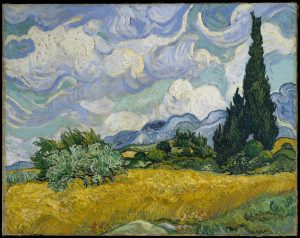The first ark work I chose in the metropolitan museum was the wintry mountains by Gong Xian. Gong Xian was a painter of the Qing dynasty. Mountains were the subject of most of his paintings. The composition of the painting is very layered. And I think the artist very cared about the space distance. In my observation, I feel like the painting contains three layers. The first layer has a stream. There are some shore stones along the stream. Near the shore, there are trees. The leaves fell to the ground because it is in winter. I see many black dots around the trees, they might be the leaves. There are couple of houses behind the trees. Four houses surrounded the courtyard in the middle, forming a shape of the well. They seem like been cut off from the world, which gives me a quiet and peaceful feeling. Behind the houses is where the second layer begin. There is a flat land along with the short mountain. The short mountain looks complex. It looks like stuck up with many stones. There are many black dots on it. They are probably the moss. The third layer starts with a row of trees. In compare to the size of the tress of the first layer, we can see there is a distance between the two layers. Behind the trees, there is another mountain. In comparing to the first mountain, it looks simpler and cleaner. I think it is because of the space distance. This mountain is further from the viewer, so the details are relatively less. Behind the mountain, there are some other houses. That adds some more human touch to the painting. The third mountain is the biggest and tallest mountain of this painting. It looks even simpler and cleaner than the second mountain. And it is fading away. It could be a foggy day or it is too far away. And it gives out a spiritual feeling. The perspective of this painting is from top to bottom. We can see the top of the mountain but also can see the side of houses. That makes the painting look more vivid and artistic.
The second art work I chose was the Wheat Field With Cypresses by Vincent Van Gogh. He was a post-impressionism painter. He mainly draw landscapes, portraits, self-portraits, and still lifes. The first thing that catched my eyes was the Cypresses on the right. The cypresses is tall and dark. It almost reaches the top frame of the printing. It gives out a fortitude and stability feeling. Then what I saw was a large gold-colored wheat field. I think it is ready for harvest. It gives out a joyful feeling. Behind the cypresses and the wheat field, we can see the silhouette of the mountain. The mountain is clean and simple. Telling us it is far away from us. Then is the cloud. The whirling cloud is in some sort of dramatic and abstract shapes. They are all over the blue sky. It is such a nice weather. Even this is a painting, you can still feel the wind is affecting the whole painting. It can easily draw you into the scene. I also really like the color palate of the painting. It is comforting and relaxing to me. There is almost no straight line in the painting. I learned that this is the most classic in conception among Van Gogh’s works.
It is a fan in rounded square shape, mounted as an album leaf. The landscape is painted in color on silk. The color used is this landscape is really dim and monochromatic. The brushwork consists of different weight and strokes, showing contrast between the nature, architecture, and the people. The painting is in extremely precise details. The details of the pavilion’s roof top, the framing structure of the pavilion, and the soft and thin strokes of folds on the clothing showed how well the artist master in painting. We can see the people are enjoying the moment with their friends. They are communicating nature and creating their work of art. The interactions of the people gives the painting movement. The trees leaning towards different directions also shows movement of the wind. The cups in the stream floating down also present movements in the painting.






